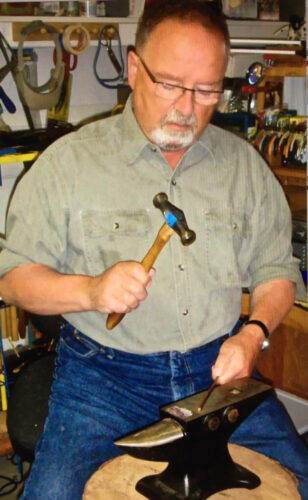Metal Arts Program Reborn Despite Cuts, Pandemic
By Tobin Jones
The petals, stem, and stamen of a wildflower, rendered painstakingly in bronze. A jarringly convincing pair of human lips cast in silver. Perusing the myriad and varied pieces produced by City College students, it’s easy to be impressed. Each started life as a piece of unremarkable raw material, which a student, under the direction of Professor Jack da Silva, melted, sawed, milled, pounded, gouged and twisted until it was reborn as a work of art.
At the risk of stretching metaphors, one could find parallels between this process and the story of the Metal Arts program over the past year. Worn and stretched by the twin crucibles of class cuts and the COVID-19 pandemic, it has returned, in a different form, to City College this fall.
When, in November of 2019, then Chancellor Mark Rocha announced plans to eliminate hundreds of classes, among them all metal arts sections, (a decision he made with no consultation from faculty or department chairs), the feeling of many was that the program’s epitaph had been written. Indeed, there seemed to be little reason for optimism, as Rocha seemed determined to follow through with the purge.
Then came COVID-19, and the indefinite shift to remote learning. If the class cuts had put Metal Arts on its last legs, the pandemic, it seemed, had chopped them off. Even if funding was restored, how could the minutiae of such delicate and technical skills be effectively conveyed through the medium of a zoom call?
When he first heard the news of Rocha’s cuts, Metal Arts Professor Jack da Silva was “very dismayed.” He and Art Department Chair Anna Acebedo set out to preserve the program in the long-term, despite the elimination of the spring semester, and were able to obtain enough funding for its reinstatement. Then, faced with the unexpected challenge of teaching the courses online, the pair hit on the idea of creating loaner tool kits for students. To supplement much reduced funding, they solicited private donations from local jewelry vendors, and were able to assemble a “very robust” collection of equipment for students to use at home.

With the understanding that the capacity of novice students would still be limited, take home tools notwithstanding, da Silva embarked on a creative redesign of the curriculum, emphasizing conceptual design much more than he had in the past. He described the resulting work by the students as “wonderful.”
While the program has managed to surmount considerable obstacles, the financial situation at City College remains grim. Acebedo told The Guardsman that every year in the recent past has seen funding reductions for her department, forcing rotations in class availability.
While she was doing her utmost, she said, to prevent the total elimination of any single skill or discipline from the course catalogue, she warned that classes taught by part time faculty such as da Silva could be particularly vulnerable in the event that further austerity measures were introduced. And although Chancellor Rocha has left the scene, his ideas, which advocated eliminating programs such as Metal Arts in favor of those seen to advance the goal of students earning degrees or transfers as quickly as possible, are still shared by many at the state and local levels.
Because of laws that prevent instructors from disclosing students’ personal information, The Guardsman was unable to speak with pupils currently enrolled in the program. However, Alison Antelman, a Metal Arts student who went on to teach the subject while running her own gallery, says that the program “changed the arc of her life.”
Another student, Danielle Jackson, who described herself as a “San Francisco born and raised, mixed-race indigenous, Black, Latinx, working-class woman,” said in a January open letter to then-Chancellor Rocha that the program had led her to feel “hopeful for a future and a stable career” for the first time in her life. She praised da Silva for having “gone out of his way to make sure we have opportunities” equal to students at private institutions, such as California College of the Arts.
While pointing out that there were many examples of Metal Arts students advancing in the field, da Silva disputed the notion that educational value could be measured purely by degrees or acceptance letters. “It’s amazing how many students we have from City that are now running their own businesses, that are working as consultants…these skills are very marketable. But I don’t like to focus on that, to be honest…What I’m trying to do is to teach a human being, holistically. I want them to be able to reason, and problem solve, and to be able to work collaboratively, and to communicate.”
